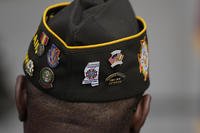FORT BENNING, Ga. -- Lightly-armed U.S. Army infantry brigades need heavier firepower -- that means light tanks and bigger guns on Stryker infantry carriers, say senior leaders here at the Maneuver Center of Excellence.
The enemy's use of home-made bombs in Iraq and Afghanistan forced the Army to make vehicle protection a higher priority than mobility and firepower, MCOE Commander Maj. Gen. H.R. McMaster said.
The Army is hoping to balance that approach with programs such as the Ground Combat Vehicle to replace the Bradley fighting vehicle and the Armored Multipurpose Vehicle to replace the M113 armored personnel carrier.
But maneuver leaders maintain that the Army cannot forget about lighter units such as Stryker and infantry brigade combat teams that currently are not equipped with enough potent firepower to win fights quickly, McMaster said.
"Across all of our formations we need the right combination of mobility protection and firepower," he said. "We need to emphasize what is next. What is the light tank that … we can give our infantry freedom of maneuver in action? And we want to up-gun our Strykers. We can see the enemy; it would be nice to be able to kill them."
Stryker Brigade Combat Teams first saw combat in Iraq in late 2003. The highly-mobile infantry force is equipped with potent variants such as the 105mm Mobile Gun System and anti-tank guided missile.
But most Stryker vehicles are infantry carriers armed with .50 caliber machine guns or MK19 automatic grenade launchers.
This has to change, argues MCOE Command Sgt. Major James Carabello.
"The Stryker needs to get up-gunned; a World War II weapon system on a Stryker? It needs a bigger gun," Carabello said. "It needs something that is a better platform than a MK 19 or a .50 caliber machine gun."
The need is now greater, officials maintain, since the Army is cutting the number of MGS Strykers from 27 to 10 per SBCT.
Currently, Training and Doctrine Command is working with Stryker program officials on a plan that could mean mounting a 30mm cannon on to the remote weapons stations on Stryker infantry carriers.
This would give much greater firepower and still not require a turret be mounted on the Stryker, Army officials say. The plan is to purchase a company set of 30mm cannons, test them, and also try to determine should they be issued for every Stryker of have one per company, officials said.
"Looking at the fire fights we have had on a continuous basis … we see the need to be able to provide an overmatch in the close fight as well for the purpose of ensuring freedom of maneuver and action of our infantry squads," McMaster said.
A .50 caliber machine gun can be very effective, "but you don't get a round that blows up and ends firefights," McMaster said.
Lightly-armed IBCTs also need mobile protected firepower such as a light tank for forced-entry style missions, Army leaders began saying earlier this year.
The conventional Army's primary unit for that mission is the XVIII Airborne Corps' 82ndAirborne Division, "but all of our IBCTs are pretty strategically mobile," Brig. Gen. David Haight, chief of infantry at Benning.
"So in the early hours and days of forcible-entry missions, we need a light-tank force that can facilitate movement and provide those light forces with additional protection and firepower."
The 82nd Airborne Division was equipped with the M551 Sheridan Armored Reconnaissance Airborne Assault Vehicle until the mid 1990s. Developed during the Vietnam War, the Sheridan resembled a light tank and featured a 152mm main gun capable of firing standard ammunition or the MGM-51 Shillelagh antitank missile.
The Sheridan was used in the Invasion of Panama in 1989 and Operation Desert Shield/Storm in 1991, but it was considered ineffective since its lightweight, aluminum armor was thin enough to be pierced by heavy machine-gun rounds, and the vehicle was particularly vulnerable to mines.
Army officials were considering the Stryker MGS, but it has proven to be less effective in off-road operations.
Maneuver officials say they would want a platform that could be air-dropped from a C-130 aircraft. It should have a base armor package capable of defeating 14.5mm ammunition. Once follow-on forces arrive, addition armor packages could be bolted on as necessary.
One option could be to take another look at the Armored Gun System, a 105mm light tank that the Army had considered as a replacement to the Sheridan in the mid 1990s.
It met the requirement in 1996 and still does, according to Benning officials, who described the AGS as "old technology that kills T72 tanks."
Don't Miss a Single Military.com Story
To read the full article and get exclusive benefits, sign up today.
It’s FREE
Why am I seeing this? Visit our FAQs



























